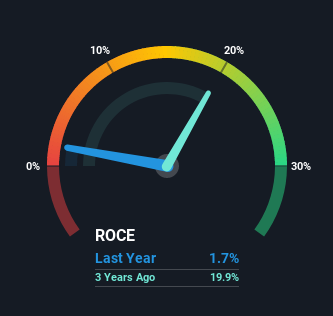Indian Terrain Fashions (NSE:INDTERRAIN) Is Reinvesting At Lower Rates Of Return
What trends should we look for it we want to identify stocks that can multiply in value over the long term? Typically, we'll want to notice a trend of growing return on capital employed (ROCE) and alongside that, an expanding base of capital employed. This shows us that it's a compounding machine, able to continually reinvest its earnings back into the business and generate higher returns. Although, when we looked at Indian Terrain Fashions (NSE:INDTERRAIN), it didn't seem to tick all of these boxes.
What is Return On Capital Employed (ROCE)?
For those who don't know, ROCE is a measure of a company's yearly pre-tax profit (its return), relative to the capital employed in the business. Analysts use this formula to calculate it for Indian Terrain Fashions:
Return on Capital Employed = Earnings Before Interest and Tax (EBIT) ÷ (Total Assets - Current Liabilities)
0.017 = ₹45m ÷ (₹4.4b - ₹1.8b) (Based on the trailing twelve months to December 2021).
Thus, Indian Terrain Fashions has an ROCE of 1.7%. In absolute terms, that's a low return and it also under-performs the Luxury industry average of 14%.
Check out our latest analysis for Indian Terrain Fashions

Historical performance is a great place to start when researching a stock so above you can see the gauge for Indian Terrain Fashions' ROCE against it's prior returns. If you're interested in investigating Indian Terrain Fashions' past further, check out this free graph of past earnings, revenue and cash flow.
What Does the ROCE Trend For Indian Terrain Fashions Tell Us?
When we looked at the ROCE trend at Indian Terrain Fashions, we didn't gain much confidence. To be more specific, ROCE has fallen from 21% over the last five years. However, given capital employed and revenue have both increased it appears that the business is currently pursuing growth, at the consequence of short term returns. And if the increased capital generates additional returns, the business, and thus shareholders, will benefit in the long run.
Another thing to note, Indian Terrain Fashions has a high ratio of current liabilities to total assets of 41%. This can bring about some risks because the company is basically operating with a rather large reliance on its suppliers or other sorts of short-term creditors. While it's not necessarily a bad thing, it can be beneficial if this ratio is lower.
In Conclusion...
Even though returns on capital have fallen in the short term, we find it promising that revenue and capital employed have both increased for Indian Terrain Fashions. But since the stock has dived 71% in the last five years, there could be other drivers that are influencing the business' outlook. Therefore, we'd suggest researching the stock further to uncover more about the business.
Since virtually every company faces some risks, it's worth knowing what they are, and we've spotted 5 warning signs for Indian Terrain Fashions (of which 2 are a bit concerning!) that you should know about.
If you want to search for solid companies with great earnings, check out this free list of companies with good balance sheets and impressive returns on equity.
New: AI Stock Screener & Alerts
Our new AI Stock Screener scans the market every day to uncover opportunities.
• Dividend Powerhouses (3%+ Yield)
• Undervalued Small Caps with Insider Buying
• High growth Tech and AI Companies
Or build your own from over 50 metrics.
Have feedback on this article? Concerned about the content? Get in touch with us directly. Alternatively, email editorial-team (at) simplywallst.com.
This article by Simply Wall St is general in nature. We provide commentary based on historical data and analyst forecasts only using an unbiased methodology and our articles are not intended to be financial advice. It does not constitute a recommendation to buy or sell any stock, and does not take account of your objectives, or your financial situation. We aim to bring you long-term focused analysis driven by fundamental data. Note that our analysis may not factor in the latest price-sensitive company announcements or qualitative material. Simply Wall St has no position in any stocks mentioned.
About NSEI:INDTERRAIN
Indian Terrain Fashions
Engages in the retail of branded apparel in India.
Mediocre balance sheet and slightly overvalued.
Similar Companies
Market Insights
Community Narratives



